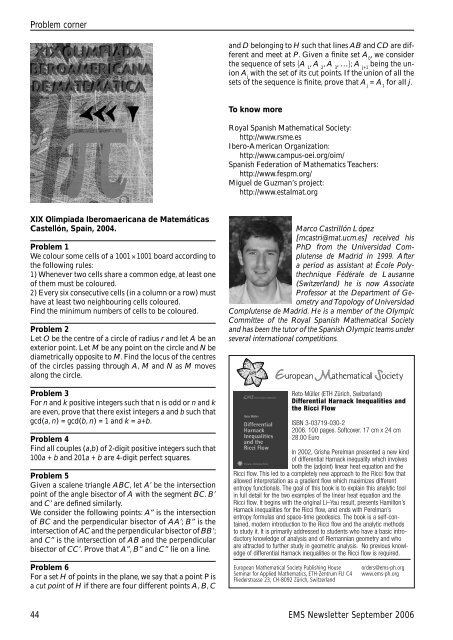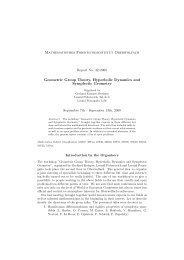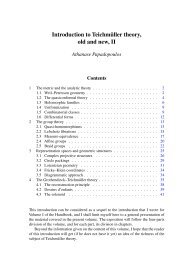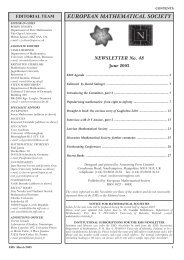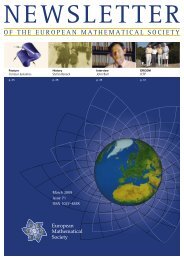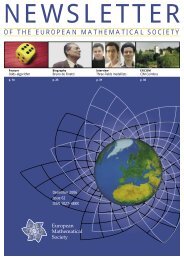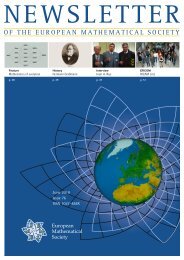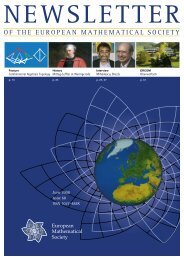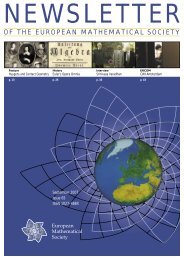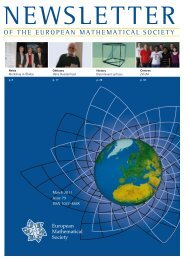OF THE EUROPEAN MATHEMATICAL SOCIETY
OF THE EUROPEAN MATHEMATICAL SOCIETY
OF THE EUROPEAN MATHEMATICAL SOCIETY
Create successful ePaper yourself
Turn your PDF publications into a flip-book with our unique Google optimized e-Paper software.
Problem corner<br />
XIX Olimpiada Iberomaericana de Matemáticas<br />
Castellón, Spain, 2004.<br />
Problem 1<br />
We colour some cells of a 1001 × 1001 board according to<br />
the following rules:<br />
1) Whenever two cells share a common edge, at least one<br />
of them must be coloured.<br />
2) Every six consecutive cells (in a column or a row) must<br />
have at least two neighbouring cells coloured.<br />
Find the minimum numbers of cells to be coloured.<br />
Problem 2<br />
Let O be the centre of a circle of radius r and let A be an<br />
exterior point. Let M be any point on the circle and N be<br />
diametrically opposite to M. Find the locus of the centres<br />
of the circles passing through A, M and N as M moves<br />
along the circle.<br />
Problem 3<br />
For n and k positive integers such that n is odd or n and k<br />
are even, prove that there exist integers a and b such that<br />
gcd(a, n) = gcd(b, n) = 1 and k = a+b.<br />
Problem 4<br />
Find all couples (a,b) of 2-digit positive integers such that<br />
100a + b and 201a + b are 4-digit perfect squares.<br />
Problem 5<br />
Given a scalene triangle ABC, let A’ be the intersection<br />
point of the angle bisector of A with the segment BC. B’<br />
and C’ are defi ned similarly.<br />
We consider the following points: A” is the intersection<br />
of BC and the perpendicular bisector of AA’; B” is the<br />
intersection of AC and the perpendicular bisector of BB’;<br />
and C” is the intersection of AB and the perpendicular<br />
bisector of CC’. Prove that A”, B” and C” lie on a line.<br />
Problem 6<br />
For a set H of points in the plane, we say that a point P is<br />
a cut point of H if there are four different points A, B, C<br />
and D belonging to H such that lines AB and CD are different<br />
and meet at P. Given a fi nite set A 0 , we consider<br />
the sequence of sets {A 1 , A 2 , A 3 , …}; A j+1 being the union<br />
A j with the set of its cut points. If the union of all the<br />
sets of the sequence is fi nite, prove that A j = A 1 for all j.<br />
To know more<br />
Royal Spanish Mathematical Society:<br />
http://www.rsme.es<br />
Ibero-American Organization:<br />
http://www.campus-oei.org/oim/<br />
Spanish Federation of Mathematics Teachers:<br />
http://www.fespm.org/<br />
Miguel de Guzman’s project:<br />
http://www.estalmat.org<br />
Marco Castrillón López<br />
[mcastri@mat.ucm.es] received his<br />
PhD from the Universidad Complutense<br />
de Madrid in 1999. After<br />
a period as assistant at École Polythechnique<br />
Fédérale de Lausanne<br />
(Switzerland) he is now Associate<br />
Professor at the Department of Geometry<br />
and Topology of Universidad<br />
Complutense de Madrid. He is a member of the Olympic<br />
Committee of the Royal Spanish Mathematical Society<br />
and has been the tutor of the Spanish Olympic teams under<br />
several international competitions.<br />
Reto Müller (ETH Zürich, Switzerland)<br />
Differential Harnack Inequalities and<br />
the Ricci Flow<br />
ISBN 3-03719-030-2<br />
2006. 100 pages. Softcover. 17 cm x 24 cm<br />
28.00 Euro<br />
In 2002, Grisha Perelman presented a new kind<br />
of differential Harnack inequality which involves<br />
both the (adjoint) linear heat equation and the<br />
Ricci flow. This led to a completely new approach to the Ricci flow that<br />
allowed interpretation as a gradient flow which maximizes different<br />
entropy functionals. The goal of this book is to explain this analytic tool<br />
in full detail for the two examples of the linear heat equation and the<br />
Ricci flow. It begins with the original Li–Yau result, presents Hamilton’s<br />
Harnack inequalities for the Ricci flow, and ends with Perelman’s<br />
entropy formulas and space-time geodesics. The book is a self-contained,<br />
modern introduction to the Ricci flow and the analytic methods<br />
to study it. It is primarily addressed to students who have a basic introductory<br />
knowledge of analysis and of Riemannian geometry and who<br />
are attracted to further study in geometric analysis. No previous knowledge<br />
of differential Harnack inequalities or the Ricci flow is required.<br />
European Mathematical Society Publishing House<br />
Seminar for Applied Mathematics, ETH-Zentrum FLI C4<br />
Fliederstrasse 23, CH-8092 Zürich, Switzerland<br />
orders@ems-ph.org<br />
www.ems-ph.org<br />
44 EMS Newsletter September 2006


